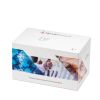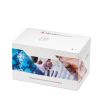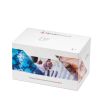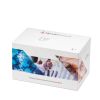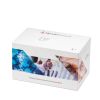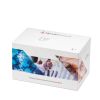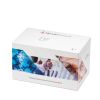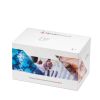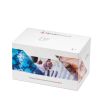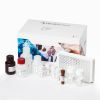Soluble mannose receptor, Human, ELISA kit – 1 x 96 det. - HK381-01
Quantity
1 x 96 det.
Catalog #
HK381-01
825,00 €
Recent studies have indicated increased concentrations of the soluble form of Mannose Receptor (MR) in plasma of patients with infection diseases such as sepsis, pneumonia and acute hepatitis. MR’s are especially expressed on cell membranes of macrophages and function as Pattern Recognition Receptors (PRR).
Exact function and (in-vivo) shedding-mechanism of the soluble form, soluble Mannose Receptor (sMR) is still unknown. Increased sMR’s in plasma can be due to some pathogens in the body which stimulate the (in-vivo) shedding mechanism of the MR’s. sMR’s which are bound to the mannose residues of these pathogens, prevent it from being recognized and phagocyted by MR’s. As a result, the innate immunity is slowly suppressed and a vicious circle (which increases the sMR’s in plasma) is created.
The body does this probably to partly slow the innate immunity to prevent going out of balance. When the disease being treated, the pathogens which are present in the body of the patient, will be less and less . In the body becoming less cleaved mannose receptors and the sMR in plasma will gradually decrease. The measurement of sMR’s in plasma may be important for the diagnoses/monitoring of diseases such as sepsis, pneumonia and acute hepatitis.
Exact function and (in-vivo) shedding-mechanism of the soluble form, soluble Mannose Receptor (sMR) is still unknown. Increased sMR’s in plasma can be due to some pathogens in the body which stimulate the (in-vivo) shedding mechanism of the MR’s. sMR’s which are bound to the mannose residues of these pathogens, prevent it from being recognized and phagocyted by MR’s. As a result, the innate immunity is slowly suppressed and a vicious circle (which increases the sMR’s in plasma) is created.
The body does this probably to partly slow the innate immunity to prevent going out of balance. When the disease being treated, the pathogens which are present in the body of the patient, will be less and less . In the body becoming less cleaved mannose receptors and the sMR in plasma will gradually decrease. The measurement of sMR’s in plasma may be important for the diagnoses/monitoring of diseases such as sepsis, pneumonia and acute hepatitis.
| Datasheet URL | https://www.hycultbiotech.com/wp-content/uploads/2022/06/hk381-0319.pdf |
|---|---|
| Quantity | 1x96det. |
| Quantity | 1 x 96 det. |
| Standard range | Measurable concentration range of 1 to 200 ng/ml. |
| Detection level | Minimum concentration which can be measured is 1 ng/ml. |
| Working volume | 100 µl/well |
| Species | human |
| Cross reactivity | Horse - No, Mouse - No, Pig - No, Rat - No |
| Alias | sMR, CD206 |
| Application | The soluble Mannose receptor (sMR) ELISA kit is to be used for the in vitro quantitative determination of sMR in plasma samples. |
| Principle | The sMR ELISA is a ready-to-use solid-phase enzyme-linked immunosorbent assay based on the sandwich principle with a working time of 3½ hours. The efficient format of a plate with twelve disposable 8-well strips allows free choice of batch size for the assay. Samples and standards are incubated in microtiter wells coated with antibodies recognizing sMR. Biotinylated tracer antibody will bind to the captured sMR. Streptavidin-peroxidase conjugate will bind to the biotinylated tracer antibody. Streptavidin-peroxidase conjugate will react with the substrate, tetramethylbenzidine (TMB). The enzyme reaction is stopped by the addition of oxalic acid. The absorbance at 450 nm is measured with a spectrophotometer. A standard curve is obtained by plotting the absorbance (linear) versus the corresponding concentrations of the sMR standards (log). The sMR concentration of samples, which are run concurrently with the standards, can be determined from the standard curve. |
| Storage and stability | Product should be stored at 4 °C. Under recommended storage conditions, product is stable for at least six months. |
| Precautions | For research use only. Not for use in or on humans or animals or for diagnostics. It is the responsibility of the user to comply with all local/state and Federal rules in the use of this product. Hycult Biotech is not responsible for any patent infringements that might result with the use of or derivation of this product. |
| Disease | Infectious diseases |
| Application assays: | The soluble Mannose receptor (sMR) ELISA kit is to be used for the in vitro quantitative determination of sMR in plasma samples. |
|---|---|
| Principle: | The sMR ELISA is a ready-to-use solid-phase enzyme-linked immunosorbent assay based on the sandwich principle with a working time of 3½ hours. The efficient format of a plate with twelve disposable 8-well strips allows free choice of batch size for the assay. Samples and standards are incubated in microtiter wells coated with antibodies recognizing sMR. Biotinylated tracer antibody will bind to the captured sMR. Streptavidin-peroxidase conjugate will bind to the biotinylated tracer antibody. Streptavidin-peroxidase conjugate will react with the substrate, tetramethylbenzidine (TMB). The enzyme reaction is stopped by the addition of oxalic acid. The absorbance at 450 nm is measured with a spectrophotometer. A standard curve is obtained by plotting the absorbance (linear) versus the corresponding concentrations of the sMR standards (log). The sMR concentration of samples, which are run concurrently with the standards, can be determined from the standard curve. |
| Perfomance: | The linearity of the assay was determined by serially diluting EDTA, citrate and heparin plasma samples. The diluted samples were measured in the assay and the curve had a slope of 0.9993. |
| Precision: | The influence of an anticoagulant in samples (heparin, citrate and EDTA) is assessed in duplicate using eight different dilutions. The CV % in this experiment ranged between 3.2 and 4.2% |



